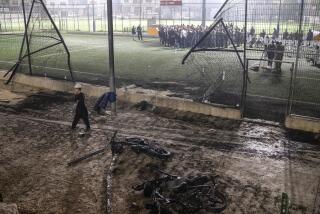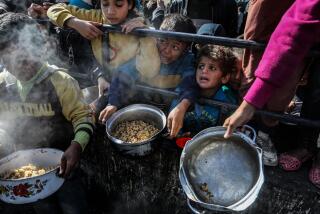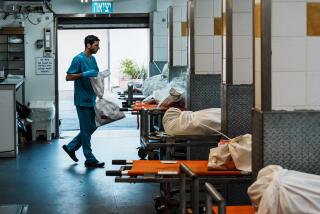The U.S. Bomb That Nearly Killed Karzai
SHOWALI KOWT, Afghanistan — The blast rocked the hilltop, scattering American and Afghan dead and wounded in a morning haze of blood and smoke. Some of the men thought the ground beneath them had been raked by Taliban mortar fire.
Yet only one thing in the Afghanistan war could convulse the earth with such force.
“As I was flying in the air, I knew,” Green Beret Capt. Jason Amerine recalled. “We were hit by our own bomb.”
One of the most celebrated bombs in the U.S. arsenal, a satellite-guided 2,000-pound explosive, had detonated on a huddle of Green Berets and allied Afghans. The “friendly fire” incident became one of the most publicized in the Afghan war and almost killed the man the Green Berets were assigned to protect: Hamid Karzai, who later that day was named the country’s interim prime minister.
Defense Department officials, speaking on condition of anonymity, say that a U.S. target finder on the ground mistakenly gave his own coordinates to a B-52 bomber pilot overhead. The bomb plunged unerringly along its deadly trajectory.
The U.S. military is still studying the Dec. 5 event. But interviews with local Afghan officials and U.S. military sources strongly suggest that the number of casualties was far greater than the Pentagon disclosed at the time. The explosion killed three Green Berets and about 25 of their Afghan allies, four times as many Afghans as initially reported. Local fighters counted nearly 80 casualties. Even today, questions linger about the total number of dead and wounded. Afghan fighters insist that some Americans were unaccounted for the next day and that a CIA agent might have been killed. CIA officials deny the report.
Today, the bomb’s crater remains in the dirt and rock, about 6 feet in diameter and 3 feet deep, on the crest of the hill where the Americans and Afghans had been meeting, as the battle waned, to plan their next mission.
“That’s the blood of the Americans,” Dr. Syed Mir Ahmad Shah, the manager of a nearby clinic, said recently as he climbed the barren hill where the massive bomb struck. He pointed out dark patches among the rocks.
“That’s another one. That’s another one.”
Battle at Village Commenced Dec. 3
The battle of Showali Kowt began Dec. 3. The northern two-thirds of the country had already been wrested from Taliban control, and Amerine and the 11 other men in his team were escorting Karzai and his band of fighters southward.
Karzai was eager to take Showali Kowt, 10 miles from the Taliban’s final stronghold of Kandahar.
After a series of firefights, the coalition forces seized the village, sending the Taliban fleeing south across a bridge over a small river.
The Taliban retook the village in a raid that night. But the Americans marked the enemy’s location with infrared pointers, visible only to an AC-130 gunship pilot in night-vision goggles overhead. The aircraft’s 105-millimeter cannons and artillery fire strafed the ground, driving the Taliban back across the bridge.
On Dec. 4, the coalition decided to take the bridge to isolate the enemy.
As Amerine moved toward it with about 60 men, a second contingent gave covering fire. A hundred yards short of a hilltop Taliban observation post, Amerine’s men took machine gun fire from Taliban troops entrenched in orchards near the riverbank.
“We were pinned down pretty well,” Amerine recalled last week in an interview at the 5th Special Forces Group headquarters in Ft. Campbell, Ky. “You poke your head up, get down and dirt would kick up around you.”
When fire raked the trench line that protected them, one Green Beret stood and raised a finger in a universal rebuke, drawing laughs from his Afghan allies. Then he declared, “Let’s go,” and led a charge that captured the observation post.
Some of the Taliban began to retreat in four-wheel-drive trucks. The Americans called in airstrikes that destroyed about 25 vehicles. The coalition forces inflicted dozens of casualties, while taking almost none.
As the fighting waned that night, the atmosphere among the Americans in Showali Kowt grew festive. They had fought for 48 hours with little food and no sleep, but now a second 12-member team of Green Berets had arrived, and a supply drop had brought care packages.
The Americans had made the clinic their headquarters. “It really was kind of like Christmas,” Amerine said. “So everybody was reading letters, sharing food with one another. Sharing it with the [Afghans].”
They congratulated Karzai on the advance word that he would be the nation’s new interim leader, a decision that would be announced in Germany the next day. Taliban surrender overtures had begun in Kandahar. It meant that Karzai would be headed for Kabul, the Afghan capital, and with the Taliban’s demise apparent, the Americans’ mission was all but over. They got their first night’s sleep in three days.
By morning, the number of Americans at the clinic had reached about 45, recalled Shah, the village doctor. Others say the number was smaller. Local Afghans and U.S. military sources said the American contingent included CIA operatives.
With Taliban still huddled in ridges across the river, a commander in the second team of Green Berets called for airstrikes to wipe out the enemy. One of two Air Force TAC-Ps, tactical air control parties whose training puts them a level below more seasoned combat controllers, calculated the distance to the enemy. He radioed in the coordinates.
Defense officials would later conclude that he relayed the wrong numbers--giving his own position instead of the enemy’s. The airman failed to reenter the target’s coordinates after changing the batteries on his global positioning system unit. After a battery change, the unit automatically displays its own location.
About 9:30 a.m. came the rumble of a Vietnam-era B-52.
At that moment, a group of soldiers who belonged to Karzai’s Pushtun ethnic group were gathered about 100 feet from the clinic. With them was Amerine’s No. 2, Master Sgt. Jefferson Donald Davis, 39, an unflappable Tennessean who two weeks earlier had helped snatch four pickups from wary Afghan fighters and headed his men toward a fight with the Taliban, yelling, “Ride ‘em like you stole ‘em!”
He was joined by Sgt. 1st Class Daniel Henry Petithory, 32, of Massachusetts, whose childhood friends knew him as “Ninja Dan.” Standing nearby was Staff Sgt. Brian Cody Prosser, 28, of Frazier Park, Calif.
Amerine sat cross-legged about 50 feet away, talking to a staff officer. Karzai sat next door to the clinic in a four-room schoolhouse, meeting with advisors.
The satellite-guided explosive landed directly at the feet of the Pushtun fighters. Davis and Petithory were killed instantly, along with about 25 Afghans. Prosser died of his wounds later that day.
The explosion knocked Amerine into the air and blew out both his eardrums, and a bolt of shrapnel tore into his leg. Rock and shrapnel shot through the clinic, where a bloodstained doorjamb records the spot where another Green Beret was standing, the doctor said. In the schoolhouse, Karzai was bloodied by flying glass that penetrated his face and head, said the doctor, who bandaged the wounds.
“A bunch of us had to keep everybody calm and say, ‘Deal with the casualties. We’re not under attack,’ ” Amerine said.
Anyone who could walk helped the medics tend to the wounded. Open chest wounds had to be packed, limbs amputated, arteries clamped, burns wrapped. One medic rushed from one patient to the next, ignoring a serious wound to his own head. Their work saved the lives of at least five Americans and numerous Afghans, Amerine said.
Recalled Shah, the local doctor: “We collected some body parts, but they could not be identified. Sometimes we could only find a head or a hand.”
The Air Force target finder survived. There is no record of him being wounded.
At its base in Pakistan, three hours away by helicopter, a team of Air Force rescue specialists was alerted by urgent radio calls.
Among them was a 32-year-old helicopter captain named Steve who had led the first Air Force choppers to the World Trade Center after the Sept. 11 terrorist attacks. He was thinking of the crumbled buildings as he suited up.
“It was surreal,” said Steve, who like other special operations soldiers asked that his last name be withheld. “To have those visions in your mind and then to be part of taking action to help ensure that America is safe from that again really gives you a sense of purpose.”
When his crew members asked for a casualty count, the response took them by surprise: “We’ll give you as many as you can take.”
Two doctors and a crew of Air Force pararescuers, or PJs, climbed into the back of two MH-53 J/M choppers, a long-range aircraft with a history of rescue missions. They left without knowing whether they were headed into a secure area or into Taliban territory.
Navy fighters escorted the choppers as they flew over Afghan airspace. The choppers skimmed the ground at 200 to 300 feet, low enough to make out individual Taliban soldiers on the ground without giving them time to launch their Soviet-era surface-to-air missiles.
The casualty numbers coming in over the radio kept rising. The extra bodies meant extra weight. The copters wouldn’t have enough fuel to make it back. Steve’s helicopter crew jettisoned equipment to save fuel.
After they descended to Showali Kowt, the PJs were taken aback. Rolling toward them was a convoy of at least half a dozen Toyota pickup trucks riddled with shrapnel, their windows blown out, one with the roof ripped off. Each carried at least two wounded men on litters.
The PJs and survivors piled one slain Green Beret and 31 of the most severely wounded men into Steve’s helicopter. Someone had draped an American flag over the Beret.
“That guy must have been carrying that flag around for weeks,” said Steve, the pilot.
The second chopper loaded up with injured, and the two aircraft lifted off for Camp Rhino, the U.S. Marine encampment near Kandahar. The PJs and doctors worked on up to three men at a time in the severely crowded aircraft, on a floor wet with the mingled blood of Afghan and American fighters. The engines drowned out the noise of the PJs amputating limbs.
In short order, both helicopters needed fuel. On the outskirts of Taliban-held Kandahar, a KC-130 air-refueling tanker answered their call and joined the formation.
Air Force rules forbid midair refueling for pilots who have been on duty more than 16 hours. Steve was in hour 23. As fuel flowed into the chopper’s nosecone, the front rotor blades missed the refueling craft by mere feet.
The helicopters reached Camp Rhino, deep in the war zone, more than an hour later and then delivered the more critically wounded to another hospital that military officials declined to name.
When they reached the hospital, the casualties included the copters themselves. A C-130 cargo plane had been dispatched with a team of mechanics to get the choppers in shape for the flight back to Pakistan.
As the mechanics peered into the back of Steve’s chopper, it looked as if someone had spray-painted the cargo space red.
“Everything was covered in blood--the walls, the litters, the cargo straps, all the equipment inside,” said Jan, a 38-year-old master sergeant and maintenance supervisor. “It looked like hell in there.”
Within three hours, the mechanics repaired the hydraulics and other problems on the aircraft and sent the crews on their way.
“A lot of lives were saved that day,” said Jan, now back at his base at Hurlburt Field, Fla. “It makes a lot of lonely times, away from the family and everything, worthwhile.”
Locals Insist That Death Toll Was Higher
Hours afterward, Pentagon spokeswoman Victoria Clarke told reporters that the errant bomb killed three U.S. service members and six allied Afghan fighters, wounding an additional 20 Americans and an untold number of Afghans.
But local commanders and villagers, including the doctor who managed the clinic that Americans used as their headquarters, insist that the death toll was much higher.
Ali Mohammed, a 25-year-old Karzai bodyguard who spent a month aboard a U.S. aircraft carrier being treated for wounds from the attack, said he and his comrades believe that the number of anti-Taliban Afghan dead is closer to 25. Precise figures remain elusive because the extent of the wounds obliterated the distinctions of nationality, and, where Afghans are concerned, there is no official tally.
“The Americans and Afghans were mixed up, so we didn’t really know who was who,” recalled Mohammed, who suffered broken arms and shrapnel wounds to his chest, abdomen and leg. Thirty more wounded Afghans were on the U.S. vessel with him, he said.
His estimate is confirmed by Karzai’s brother, Ahmed, who is now on the local governing council in Kandahar. Ahmed Karzai said his brother lost 25 men.
“It was hard to count because there were lots of body parts and they loaded them so fast into the helicopter,” Ahmed Karzai said in an interview.
Pentagon officials have declined to comment on the incident, citing an ongoing investigation. Asked about the account offered by Ahmed Karzai and Mohammed, Rear Adm. Craig Quigley, chief spokesman for the U.S. Central Command, which is directing the war, said he had no reason to challenge it.
“I would simply defer to those Afghans in a position to know,” Quigley said. “We do not have good numbers.”
Afghan fighters and villagers dispute even the official account of American casualties. Though military casualties would be especially difficult to hide because officials must notify families, there is another government employer, the Central Intelligence Agency, that reserves the right to withhold such information.
By local accounts, there were far more Americans at Showali Kowt than the Green Berets described by the Pentagon.
Asked about the discrepancy between the Pentagon figures on Americans at the battle and those of witnesses at the scene, one military official said the Pentagon numbers did not account for CIA officers accompanying Karzai. Pentagon officials simply omit information on officials from “OGAs”--other government agencies--such as the CIA.
“We have been forthcoming on every American--well, certainly every [Department of Defense] death in the war,” Quigley said. Asked if that meant the Pentagon would not report the activities of employees of other agencies, such as the CIA, he said, “That’s correct.”
A U.S. intelligence official confirmed that CIA officers were in the area, although not necessarily in the battle. The official said he knew of no CIA operative injured in the battle.
The CIA official attributed the dispute over the number of dead to “the fog of war.”
(BEGIN TEXT OF INFOBOX / INFOGRAPHIC)
The Aftermath of ‘Friendly Fire’
More to Read
Sign up for Essential California
The most important California stories and recommendations in your inbox every morning.
You may occasionally receive promotional content from the Los Angeles Times.










